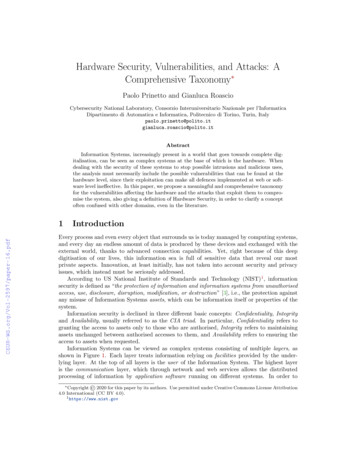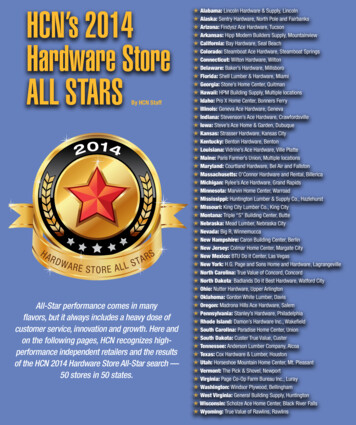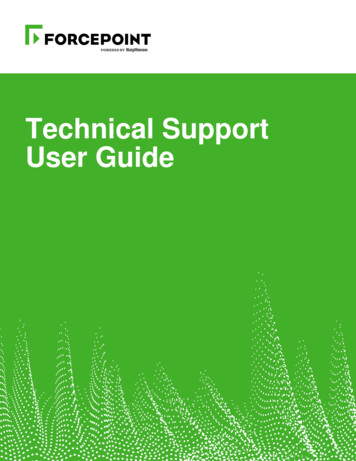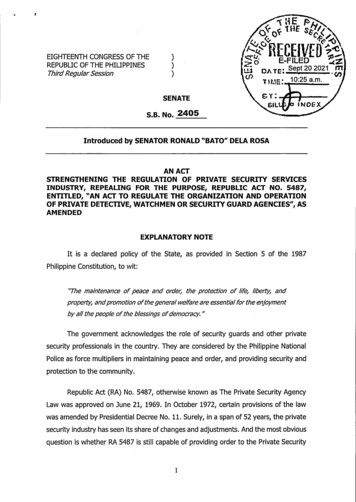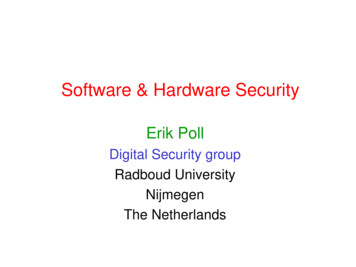
Transcription
Software & Hardware SecurityErik PollDigital Security groupRadboud UniversityNijmegenThe Netherlands
Nijmegen2
Digital Security groupRigorous & formal methods to design & analyse secure ICT systemsIncl. societal impact, esp. on privacyAlso looking at concrete applications
software securityhardware security smartcards & RFIDattacks buffer overflows in C( ) web problems: attacksSQL inj, XSS, CSRF,.defenses security testing static analysisfor Java & C bank cards e-passportonline privacy &cybercrime4
The problem
pre-history of hackingIn 1950s, Joe Engressia showed the telephone networkcould be hacked by phone phreaking:ie. whistling at right frequencieshttp://www.youtube.com/watch?v vVZm7I1CTBsIn 1970s, before founding Apple together with Steve Jobs,Steve Wozniak sold Blue Boxes for phone phreaking at university6sws1
Slammer Worm (2003)Pictures taken from The Spread of the Sapphire/Slammer Worm, by David Moore, Vern Paxson, Stefan Savage, Colleen Shannon, Stuart Staniford,Nicholas Weaver7
Slammer Worm (2003)Pictures taken from The Spread of the Sapphire/Slammer Worm, by David Moore, Vern Paxson, Stefan Savage, Colleen Shannon, Stuart Staniford,Nicholas Weaver8
9
Top secret NSA slides leaked by Edward SnowdenMore info at http:// leaksource.info andhttp:// www.theguardian.com/us-news/the-nsa-files10
11
12
Security problems of past days To get an impression of the scale of the problem,have a look ov/ncas/bulletinshttp://www.securitytracker.com/13
QuizWhat do laptops, tablets, mobile phones, wifi accesspoints, network routers, bank cards, e-passports, eIDcards, smartphone apps, web sites, web browsers,web servers, operating systems, firewalls, intrusiondetection systems, cars, and airplanes have incommon?Why can all these things be hacked, if we are notvery careful?There is SOFTWARE inside them!14
Software (in)security Software is the main source of security problems.– Software is the weakest link in the security chain, with thepossible exception of “the human factor” Software security does (did?) not get much attention– in other security courses, or– in programming courses,or indeed, in much of the security literature!Computer security courses traditionally focus on cryptography f besolve by cryptography, you do not understand cryptography and you do notunderstand your problem” [Bruce Schneier]15
“if you think your problem can be solved by cryptography,then you do not understand cryptographyand you do not understand your problem”[Bruce Schneier]16
Superficial analysis of the problem17
Observation 1All these problems are due to (bad) softwareNamely software in the Linux/Windows/Mac operating system (OS) web servers web browsers the router software .Because of these software bugs constant patching ofsystem is needed to keep them secure18
Observation 2All these problems are due to bad software that can be executed/addressed over the network– eg. in case of Slammer worm executes on (untrusted) input obtained over thenetworkor bothWith ever more network connectivity,ever more software can be attacked.19
Changing target of attacks Traditionally, focus of attacks was on operating system and network“Solutions”– regular patching of OS– firewalls– virus scannersIncreasingly, focus on web applications web browser mobile devices smartphones, tablet, that pass through firewalls embedded software software in cars, factories, infrastructure.and targetted attacks on specific organisation or person(known as ATP Advanced Persistent Threat)20
Changing nature of attackersTraditionally, hackers were amateurs motivated by fun publishing attacks for fame & glory attacks creating lots of publicityIncreasingly, hackers are professional attackers go underground zero-day exploits are worth a lot of moneyAttackers increasingly include organized crimewith lots of money and (hired) expertise government agencies:with even more money & in-house expertise21
stuxnet attackMalware (by US and Israel?) attacking nuclear enrichment facility in Iranhttp://www.ted.com/talks/ralph langner cracking stuxnet a 21st century cyberweapon.html22
Software (in)security: crucial facts No silver bullets!crypto or special security features do not magically solve allproblems Security is emergent property of entire system– just like quality (Non-functional) security aspects should be integral part of thedesign, right from the start23
We focus on software security now, but don’t forgetthat security is aboutpeople (users, employees, sys-admins, programmers,.), andtheir laziness, mistakes, stupidity, incompetence, confusion,software, bugs, verification, hackers, viruses, testing,operating systems, networks, databases, hardware,access control, passwords, smartcards, biometrics, cryptology,security protocols, security policies & their enforcement,monitoring, auditing, risk management, complexity,legislation, persecution, liability, public relationspublic perception, conventions, standards, .24
The causes of the problem25
Quick audience poll How many of you learned to program in C or C ? How many had it as a first programming language? How many of your C( ) courses warned you about buffer overflows? explained how to avoid them?Major causes of problems are lack of awareness lack of knowledge irresponsible teaching of dangerous programminglanguages26
Quick audience poll How many of you have built a web-application?– in which programming languages? What is the secure way of doing a SQL query in thislanguage? (to avoid SQL injection flaws)Major causes of problems are lack of awareness lack of knowledge27
1. Security is always a secondary concern Security is always a secondary concern– primary goal of software is to provide somefunctionality or services;– managing associated risks is a derived/secondaryconcern There is often a trade-off/conflict between– security– functionality & conveniencewhere security typically looses out more examples of this later.28
29
Functionality vs security Functionality is about what software should do,security is (also) about what it should not doUnless you think like an attacker,you will be unaware of any potential threats30
Functionality vs security: Lost battles? operating systems (OSs)– with huge OS, with huge attack surface programming languages– with easy to use, efficient, but very insecure and error-pronemechanisms web browsers– with plug-ins for various formats, javascript, ActiveX, Ajax . email clients– which automatically cope with all sorts of formats &attachments.31
Functionality vs security : PHP"After writing PHP forum software for three years now,I've come to the conclusion that it is basicallyimpossible for normal programmers to write securePHP code. It takes far too much effort. . PHP'sraison d'etre is that it is simple to pick up and make itdo something useful. There needs to be a major push. to make it safe for the likely level of programmers newbies. Newbies have zero chance of writingsecure software unless their language is safe. . "[Source http://www.greebo.cnet/?p 320]32
2. Weakness in depthinterpretable or executable inputeg paths, filenames, .doc, .xls, .pdf, .js,.programming languagesapplicationwebbrowserwith pluginsplatformeg Java or .NEToperating systemmiddlewarelibrariessystem APIssqldatabasehardware (incl network card & peripherals)33
2. Weakness in depthSoftware runs on a huge, complicated infrastructure– OS, platforms, webbrowser, lots of libraries & APIs, . is built using complicated languages & formats– programming languages, but also SQL, HTML, XML, . using various tools– compilers, IDEs, preprocessors, dynamic code downloadsThese may have security holes, or may make theintroduction of security holes very easy & likely34
RecapProblems are due to lack of awareness– of threats, but also of what should be protected lack of knowledge– of potential security problems, but also of solutions compounded by complexity– software written in complicated languages, using large APIs ,and running on huge infrastructure people choosing functionality over security35
Security concepts & goals
Security Security is about regulating access to assets– assets can be information, functionality, or physical assets– Software provides functionality– eg on-line exam results This functionality comes with certain risks– eg what are risks of on-line exam results? (Software) security is about managing these risks37
Starting point for ensuring security Any discussion of security should start with an inventory of– the stakeholders – ie. who is involved– their assets, and– the threats to these assetsby possible attackers– employees, clients, script kiddies, criminalsAny discussion of security without understanding theseissues is meaningless:You have to know what you want to secure,against what type of attacks, and against who38
Security conceptsGoal of security is to reduce risks to acceptable levels, Security is never 100%So you have to know what you want to secure,against what type of attacks, against who,and at what cost39
Security Objectives: CIA Confidentiality– unauthorised users cannot read information Integrity– unauthorised users cannot alter information Availability– authorised users can access information– ie. preventing DoS (Denial of Service) attacks Non-repudiation or accountability– authorised users cannot deny actions40
Security objectives Integrity nearly always more important thanconfidentialityEg think of– your bank account information– your medical records– all the software you use, incl. the entire OS41
How to realise security objectives? AAAA Authentication– who are you? Access control/Authorisation– control who is allowed to do what– this requires a specification of who is allowed to dowhat Auditing– check if anything went wrong Action– if so, take action42
How to realise security objectives?Other names for the last three A's Prevention– measures to stop breaches of security goals Detection– measures to detect breaches of security goals Reaction– measures to recover assets, repair damage, and persecute(and deter) offenders43
Try to prevent, but also detect and reactNever think that good preventionmakes detection & reaction superfluous.Eg. breaking into house or office is often easy;only detection & reaction seriously deters burglars.Detection of digital break-in is harderwho noticed a break-in on his computer recently?Reaction (incl. prosecution) is even harderhow to find the person responsible,somewhere on the internet?
Software security
warning: confusing terminologyCommon use of terminology can be very confused & confusing:(security) weakness, flaw, vulnerability, bug, error, coding defect.We can make a distinction between a security weakness/flaw:something that is wrong or could be better a security vulnerabilitya weakness/flaw that can actually be exploited by an attacker,which requires the flaw to be- accessible: attacker has to be able to get at it- exploitable: attacker has to be able to do some damage with itEg by unplugging your network connection,some (many?) vulnerabilities become flaws.46
software vulnerabilitiesSoftware vulnerabilities can be introduced at two “levels” design flawsvulnerability in the design bugs aka implementation flaws or code-level defectsvulnerability in the software introduced when implementing asystemRough consensus: bugs and design flaws are equally commonVulnerabilities also arise on other levels (out of scope for now) configuration flaw when installing software on a machine the user unforeseen consequence of the intended functionality (eg. spam)47
Typical software security vulnerabilities17%0%37%buffer overflowinput validationcode defectdesign defect26%crypto20%Security bugs found in Microsoft bug fix month (2002)48
bugs aka implementation flaws aka code-level defectsThere are roughly two kinds of implementation flaws1. bugs that can be understood looking at the program itself(and understanding what it is meant to do!)– eg. , simple typos, confusing two program variables, off-by-one error inarray access, .– sometimes called logic errors, as opposed to syntax errors,or an errors in the program logic2. lower-level problems that can only be spotted if you understandthe underlying platform of the program in execution, eg– buffer overflow,integer overflow,. in binaries compiled from C( )– SQL injection, XSS, CSRF,. in web-applications49
The big problem of software securityThe bad newspeople keep making the same (types of) mistakesThe good newspeople keep making the same (types of) mistakes so we can do something about it!“Every advantage has its disadvantage ” -- Johan Cruijff50
security in thesoftware development life cycle
Tackling Software Insecurity Knowledge about standard mistakes is crucial in preventingthem– these depends on the programming language, the “platform”(OS, database systems, web-application framework, ), andthe type of application– lots of info available on this now But this is not enough: security to be taken into account from thestart, throughout software development life cycle– several ideas & methodologies to do this52
Security in Software Development Life CycleMcGraw’s Touchpoints[Gary McGraw, Software security, Security & Privacy Magazine,IEEE, Vol 2, No. 2, pp. 80-83, 2004. ]53
Methodologies for security in development life cycleCommon/best practices, with methods for assessments, androadmaps for improvement McGraw’s TouchpointsBSIMM Building Security In – Maturity Modelhttp://bsimm.com Microsoft SDL Security Development Lifecycle OpenSAMM Software Assurance Maturity Modelhttp://opensamm.org54
Microsoft’s SDL Optimisation Model55
BSIMMBased on data collected from large enterprises56
Spot the (security) flaws in electronic purse.cint balance; should be what if amountis negative?void decrease(int amount){ if (balance amount){ balance balance – amount; }else { printf(“Insufficient funds\n”); }}void increase(int amount){ balance balance amount;}what if this sum istoo large for an int?57
Different kinds of implementation flawswhat if amountis negative? lack of input validation of (untrusted) userinput– could be a design flaw rather than animplementation flaw?– more “fundamental” than the flawsbelow should be simple mistake in the program logic potential problem depending on how theunderlying platform work, eg. in case ofan integer overflow;– “lower level” than the flaws abovewhat if this sum istoo large for an int?58
More info Gary McGraw,Software security,Security & Privacy Magazine, IEEE, Vol 2, No. 2, pp. 80-83,2004. Check out litiesfor security alerts in the past week59
Software (in)security Software is the main source of security problems. -Software is the weakest link in the security chain, with the possible exception of "the human factor" Software security does (did?) not get much attention -in other security courses, or -in programming courses, or indeed, in much of the security literature!
